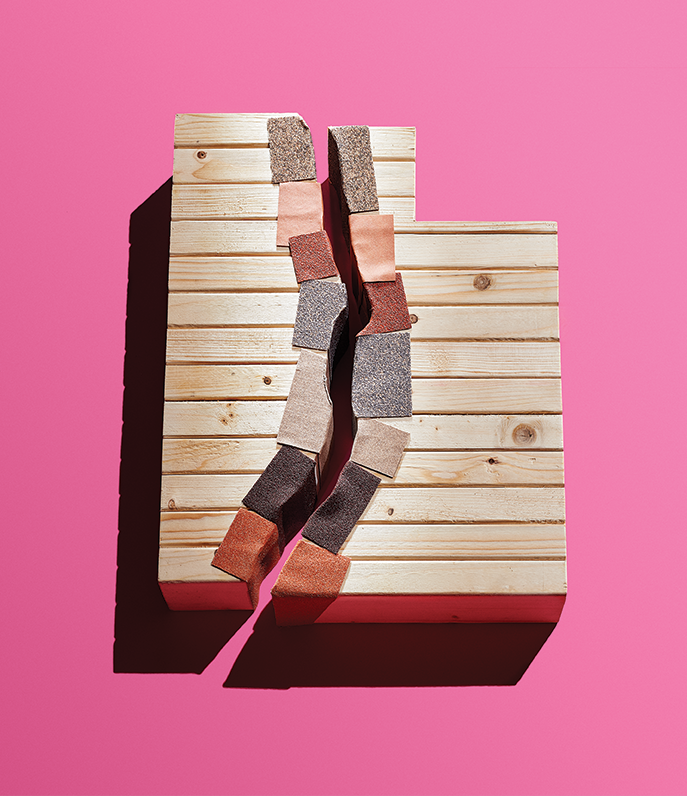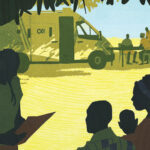At 7:08 a.m. on March 18, the power grid in Salt Lake City hummed along, bricks on buildings sat squarely mortared in place, and dishes and knickknacks rested quietly on shelves.
The number of people in the Salt Lake Valley who knew what a moderate-sized earthquake felt like was small. Maybe they’d lived in California or Alaska or another part of the world where earthquakes are frequent. Maybe they had been around in 1962 when a magnitude 5.2 quake shook the valley.
By 7:09, though, everyone knew.
A rumble at first and then a shudder, long enough to disperse anyone’s first thoughts that it might be a large truck passing by, reawakened the truth that this is earthquake country.
Within minutes, the University of Utah Seismograph Stations, or UUSS, reported that the quake measured a magnitude of 5.7 with the epicenter in Magna, Utah.
By seismological standards, the earthquake was only moderate. But it was the strongest quake recorded on the Wasatch Fault—and a sharp reminder of the potential for larger quakes to come. U scientists and other experts are learning all they can about this event and helping Utahns get ready for the next one.
Whoa. Was that an earthquake?
Yes. And as soon as UUSS director Keith Koper realized that, he dove under his desk to ride out the shaking. “My cat came flying by,” he says. “She was looking at me like it was my fault.”
He then called associate director Kris Pankow and set into motion plans that their team had practiced many times—with some modifications for the COVID-19 pandemic. Just two days before, the staff had started working remotely.
Koper drove to campus to speak to the media and coordinate with state and university leaders. “And when I got there, there was actually a news crew waiting at the door for me to get in,” he adds.
Since 1966, UUSS has been the go-to source for earthquake information in Utah and beyond. The network of stations, now numbering more than 200 and with locations around the state and Yellowstone region, relays information in real time, providing the building blocks for earthquake data reporting and maps of ground shaking within minutes of a quake.
That reputation drew the media crews to the U, where the first news conference of the day began via Zoom with Koper and Bob Carey, earthquake program manager for the Utah Department of Public Safety, answering reporters’ questions.

Load the car. I heard a bigger quake is coming.
Hold your horses. That news didn’t come through official channels. Even during the news conference, rumors began flying on social media. One claimed that the U was predicting a 9.0 earthquake within “the next two hours.” Another claimed that Utah’s oil refineries were out of commission, leading people to stock up on fuel.
Part of the confusion came from misunderstandings about how seismology works and how earthquakes happen. Quakes can’t be predicted, says Pankow. And the Wasatch Fault simply isn’t big enough to produce enough energy for a magnitude 9.0 quake. The strongest we could see is around a magnitude 7.0 to 7.3—still plenty large enough that it’s what some call “The Big One.”
Here’s how earthquakes happen: If you pull something elastic, like a rubber band, it will stretch, but only to a point. When you stretch it too far, small cracks begin to form and—snap!—the band breaks with a jerk.
It’s that sudden release of energy that causes an earthquake, says Pankow. “Roughly eight to 10 kilometers [five to six miles] below the earth, there was a patch of area on this fault plane all along this crack where the stress exceeded the strength. When you’ve built up enough strain on the fault, those patches break.”
It was in Magna?
Yeah, all the way in Magna, about 14 miles west of Salt Lake. That’s where Danny Colosimo BS’79 lives. He’s the co-owner of Colosimo’s Standard Market, on the city’s Main Street. He was a child in the 1962 quake, also centered in Magna. But the 2020 quake, he says, felt much more violent. “This felt like you were sinking,” he says, “or somebody had just grabbed and pushed on the house.”
Soon after checking on his neighbors, he drove down to Main Street to check on the store. He saw the damage as soon as he arrived. “And that’s when my heart sank,” he says. The bricks from an upper portion of the side wall had crashed to the sidewalk. Still, Colosimo was grateful. A food delivery had been scheduled for later that morning. “Had I been there I could have been crushed.”
Colosimo was surprised that the quake occurred on the Wasatch Fault, which comes to the surface at the base of the Wasatch Mountains, on the east side of the Salt Lake Valley. Magna is on the west side, at the base of the Oquirrh Mountains.
“We all hear about the Wasatch Fault,” Colosimo says. “You know, that’s a big, well-known fault. I had no idea that Magna was on it.”
Well, fault planes aren’t always straight lines plunging into the earth. The Wasatch Fault bends as it gets deeper and flattens out. It underlies the entire valley.

Yep, that was an aftershock.
One of many. As of June 24, UUSS had recorded 2,320 aftershocks in what’s now being called the “Magna sequence” of earthquakes. Pankow has another analogy to talk about aftershocks. Picture two wooden boards, she says, both covered in sandpaper. Now try to slide them past each other. “You have a lot of friction,” she says. “It doesn’t just slide smoothly, right? It sort of jumps.” All of those jumps are part of a sequence of earthquakes, as a fault tries to settle back to rest. For very large earthquakes, aftershocks may continue for years—or decades.
“It’s re-equilibrating,” Pankow says. “And it’s just getting to where it’s locked back together. All of those aftershocks are the earth sort of recovering from that big pull.”
In a sequence, the largest event is called the “mainshock.” Any that come before are called foreshocks, and any that follow are called aftershocks. In the Magna sequence, the mainshock was the very first. So when is a sequence over? Generally when seismic activity has settled down to background levels, Pankow says.
Aftershocks are a scientific opportunity. Because the risk of aftershocks decreases with time, U geoscientist Amir Allam jumped right into action on the day of the first quake to gather what data he could.
Allam had felt his fair share of quakes living in Southern California and Alaska. So when he woke up to his house shaking, he immediately started counting. Earthquakes consist of several types of seismic waves, and the time difference between them, he says, can give you an idea of how far away the quake was. It’s like counting the time between a flash of lightning and a clap of thunder.
“Then once I realized it was close by,” he says, “I jumped up and said, Okay, it’s time to go to work. And I rushed into the office to get my sensors ready.”
Geoscientists can learn a lot about the subsurface with every quake and aftershock. The pulses of energy that ripple through the layers of rock reveal faults and other features in the Earth, similar to the way a CT scan uses X-ray pulses to reveal features inside the body.
Allam and his colleagues began placing portable seismometers, each a little smaller than a coffee can, to record seismic events. Their first stop was a landfill near the epicenter. “It was just the foulest smell,” he says. “It’s the nastiest field work I’ve ever done, digging in mucky mud.” Next, they went to the construction site of a new Utah State Prison.
“I had just stuck a sensor in the ground,” he says, “and I stood up and bang! There was a deep, deep reverberating, blasting sound. And then the ground shook.” It was a magnitude 4.6 aftershock, directly under his feet. “That was really cool.”
Four weeks and thousands of aftershocks later, UUSS researchers retrieved the sensors. It will take time to process all the data—but first looks suggest that the technicians’ quick work will yield scientifically beautiful results.
Ugh. I can’t take any more. With everything else that’s going on…
That’s a normal feeling, says Michelle Ertl, a psychologist at the Utah Center for Evidence Based Treatment. “Being more aware, being more on guard, all of that is completely normal and typical,” she says.
Any traumatic event sets our brains into a state of hyper-alert, says Ertl, who helped clients work through earthquake-related anxieties. Heightened awareness helps us stay prepared in case additional threats emerge. Re-regulating can take weeks. And repeated aftershocks aren’t helpful. “When there’s this consistent reactivation, it can take a little bit longer for that re-regulation to happen.
Up until mid-March, Utahns had been shopping and attending school, church, and sporting events as usual. But COVID-19-related closures rolled out through that week, sweeping nearly all of those activities out of daily life. Which is just when the ground started shaking. Repeatedly.
“A lot of people had stress levels that were already high,” Ertl notes. Physical distancing measures also meant that people didn’t have access to some of the social support they would normally lean on to cope, she says.
So emotional preparedness is a thing, too, just like storing water and food. Learn how you best manage stress and anxiety, Ertl says, and maybe include in your emergency kit some kind of game or distraction for when the event is over, to reassure your brain that things are safe.
“Your body is doing what it’s designed to do to keep you safe,” she says. “The majority of people will recover on their own over time.”
Jeez, I really wasn’t ready. Good this wasn’t bigger.
Yes, things could have been much worse. Welcome to Bob Carey’s world. At the Utah Earthquake Program, he and his team run simulations to prepare for various earthquake scenarios. For this quake, he says, some things were much less complicated. Many parents were working remotely, and schools had already been closed. Utah’s hospitals were prepared for a surge of patients.
Out of simulations (as well as moderate quakes such as this one) arise recommendations and plans to minimize damage and accelerate recovery. The vulnerability that many felt, he says, can become a constructive tool to help prepare for future emergencies.
“You’re used to turning the light on,” he says. “You’re used to turning on the faucet, and you just don’t think twice about that. When people start to feel vulnerable, that’s when they actually start to do things.”
Carey, Pankow, and others who pay acute attention to Utah’s seismic hazards see an opportunity. The risk of a large earthquake on the Wasatch Fault is suddenly more real.
“When I do outreach talks, people say, ‘You’ve been telling me for 20 years that there’s going to be an earthquake, and I still haven’t felt one. You need to change your story,’ ” says Pankow. “Right. And now we’ve had that event.”
About the author: Paul Gabrielsen is a research and science writer for University Marketing & Communications.
Earthquake 101
Whether you grew up doing drop-and-cover drills or are a new resident of quake country, it’s always good to review the basics. We chatted with Bob Carey, the Earthquake Program manager for the Utah Department of Public Safety, to learn the fundamentals of earthquake safety.
BEFORE AN EARTHQUAKE
Know your building’s seismic status
Seismic building codes were enacted in the ’70s, so structures built before 1975 were constructed without seismic reinforcement. Some have since been retrofitted—but many haven’t.
Make a plan
Have a game plan for how family members will meet up after an earthquake and where you’ll go if your home is damaged. Think of common places people might be, like work and school, and various weather conditions.
Store two weeks’ worth of supplies
In serious emergencies, individuals and families may need to have 14 days’ worth of necessities on hand to tide them over until utilities and government aid services can reach them.
Strategize ways to cope with stress and anxiety
Any crisis can create feelings of anxiousness and worry. In your emergency planning, include diversions and stress-management techniques.
DURING THE SHAKING
Drop and cover
The bulk of injuries in an earthquake are from falling debris. Getting under a table, desk, or counter protects you from that debris, which can include plaster, masonry, or even elements like HVAC systems in commercial buildings.
And hold on
Furniture that you take cover under may move during the shaking, so hold on to it. If you can’t find cover, kneel adjacent to an interior wall, covering your head and neck with your arms.
Don’t go from inside to outside or vice versa
Especially for buildings with unreinforced masonry, the area just outside can be hazardous because of falling debris. Running into or out of a building puts you at risk.
AFTER THE SHAKING STOPS
Handling natural gas
Unless you smell a natural gas leak (a rotten egg odor), there is no need to shut off the natural gas supply to your house.
Watch for aftershocks
Aftershocks can occur for days, weeks, and even months after an initial earthquake, with timing and magnitude that can’t be exactly predicted. Maintain readiness.
Get your news from official channels
In the aftermath of a scary and confusing event, rely on news from official government and news sources. News on social media travels fast but is difficult to verify.
Keep an eye on mental health
Anxiety for a few weeks following a trauma is normal, but if it persists for several months, it might be time to seek additional help.
For more ways to prepare, go to utah.gov/beready.



I experienced a 4.5 in the early 80’s in the same area, but the intensity of this one was truly 10+-fold. Violent and loud! I’ve never had anxiety issues but this quake resulted in months of strong PTSD symptoms. Just recently have I started to feel better. The pandemic truly exacerbated this experience, not only from a stress standpoint, but also due to the fact that my fight/flight response was fully engaged. You can’t fight an earthquake, but due to the pandemic, there was no flight either. Stay home, stay safe, I believe the slogan was. The only problem was that my home was certainly not a place that I felt safe. Each subsequent aftershock was traumatizing to me, and sort of set me back to square one each time. This continued for months since the last felt aftershock in this area on 7/25. A 2.5, I believe. Nice to know the aftershock sequence is diminishing.
In the early 70’s my teachers said the “big one would come any now to the next 15 years.” We are still hearing that same wording 47 years later.
I can imagine that it was a very scary situation. I felt a 4.7 many years ago as an aftershock to the Big Northridge, CA quake in 1994. It felt like the house was being raised and dropped from 5 feet in the air!
The quote,”… the Wasatch Fault simply isn’t big enough to produce enough energy for a magnitude 9.0 quake. The strongest we could see is around a magnitude 7.0 to 7.3…” was the most significant to me. I would love to hear an expanded discussion on the effects and impact of a 7.3 earthquake.
The faults in Magna need to be better studied and documented. Just like the Wasatch fault….it doesn’t make sense to pay attention to one fault and not give as much notariety to the others.